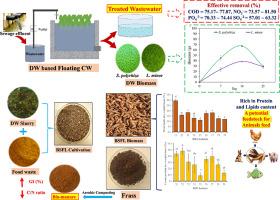一种新型生物循环系统:多根螺旋体和小柠檬在污水植物修复和黑虻幼虫养殖原料生产中的双重应用
IF 8.1
2区 环境科学与生态学
Q1 ENVIRONMENTAL SCIENCES
引用次数: 0
摘要
本研究探讨了利用浮萍(DW)种多根螺旋藻(S. polyrhiza)和小Lemna minor (L. minor)进行城市污水植物修复的综合可持续方法,并评估了收集的浮萍生物量作为黑兵蝇幼虫(BSFL)养殖原料的潜力。DW对污水的植物修复对NO3-N(73.57 ~ 81.50)、NH4+- N(42.13 ~ 63.89)、PO4−3(70.33 ~ 74.44)、SO4−2(57.01 ~ 63.32)和COD(75.17 ~ 77.87)的去除率显著(%),表明该漂浮系统适合污水处理。在植物修复装置下,DW生物量的生产速率为128.15±0.77 g-fresh weight/m2/day(多根草)和73.26±0.85 g-fresh weight/m2/day(小草)。生化分析显示,收获的DW生物质中总碳水化合物(13.68% - 19.80%)、粗蛋白质(24.63% - 28.47%)、脂质(17.13% - 20.71%)和淀粉(13.46% - 17.21%)含量均有所增加,凸显了其作为BSFL培养原料的潜力。然而,单独使用DW作为BSFL饲料可能不实际,但与食物垃圾(FW)结合使用可以取得令人满意的结果。因此,以不同的比例(30%、50%、70%和100%)将粪料与FW混合,BSFL培养结果表明,在粪料为30%的废物混合物中,饲料转化率、生物转化率和BSFL生长均较高。BSFL草籽萌发指数(GI)较低(10.50 ~ 42.60%),不适合用作肥料。为了解决这一问题,对草进行了28天的好氧堆肥,显著提高了GI(70%),并使粪便富含有价值的土壤养分(N, P和K),证实了其作为植物盆栽介质的潜力。综上所述,BSFL综合废水植物修复和植物生物量增值为解决水污染和杂草根除提供了一种低成本、可持续的解决方案,同时通过生产富含蛋白质的动物饲料和生物粪便实现资源回收。本文章由计算机程序翻译,如有差异,请以英文原文为准。

Dual application of Spirodela polyrhiza and Lemna minor in sewage phytoremediation and feedstock production for black-soldier fly larvae cultivation: A novel bio-circular system
This study investigates an integrated and sustainable approach to urban sewage phytoremediation using the duckweed (DW) species Spirodela polyrhiza (S. polyrhiza) and Lemna minor (L. minor), as well as assessing the potential of harvested DW biomass as feedstock for black soldier fly larvae (BSFL) cultivation. Phytoremediation of sewage by DW caused significant removal (%) of NO3–N (73.57–81.50), NH4+- N (42.13–63.89), PO4−3 (70.33–74.44), SO4−2 (57.01–63.32), and COD (75.17–77.87), indicating the suitability of such floating systems for sewage treatment. DW biomass exhibited a high production rate of 128.15 ± 0.77 g-fresh weight/m2/day (S. polyrhiza) and 73.26 ± 0.85 g-fresh weight/m2/day (L. minor) in phytoremediation setups. Biochemical analysis revealed increased (dry-weight basis) content of total carbohydrates (13.68 %–19.80 %), crude protein (24.63 %–28.47 %), lipids (17.13 %–20.71 %), and starch (13.46 %–17.21 %) in harvested DW biomass, highlighting its potential as a feedstock for BSFL cultivation. However, using DW alone as BSFL feed may not be practical, but promising results can be achieved when combined with food waste (FW). Consequently, DW was mixed with FW at various ratios (30 %, 50 %, 70 %, and 100 %), and BSFL cultivation results indicated high feed conversion ratios, bioconversion rates, and BSFL growth in waste mixtures with 30 % DW. BSFL frass was also analyzed for potential use as manure, but was found unsuitable due to the low seed germination index (GI) (10.50–42.60 %). To address this, the frass was aerobically composted for 28 days, which significantly improved the GI (>70 %) and enriched the manure with valuable soil nutrients (N, P, and K), confirming its potential as a plant potting medium. In summary, integrated wastewater phytoremediation and plant biomass valorization in BSFL cultivation present a low-cost, sustainable solution for addressing water pollution and weed eradication, while enabling resource recovery through protein-rich animal feed and bio-manure production.
求助全文
通过发布文献求助,成功后即可免费获取论文全文。
去求助
来源期刊

Chemosphere
环境科学-环境科学
CiteScore
15.80
自引率
8.00%
发文量
4975
审稿时长
3.4 months
期刊介绍:
Chemosphere, being an international multidisciplinary journal, is dedicated to publishing original communications and review articles on chemicals in the environment. The scope covers a wide range of topics, including the identification, quantification, behavior, fate, toxicology, treatment, and remediation of chemicals in the bio-, hydro-, litho-, and atmosphere, ensuring the broad dissemination of research in this field.
 求助内容:
求助内容: 应助结果提醒方式:
应助结果提醒方式:


